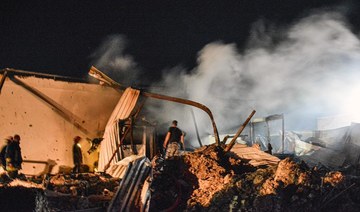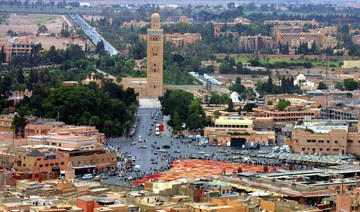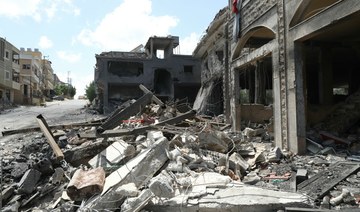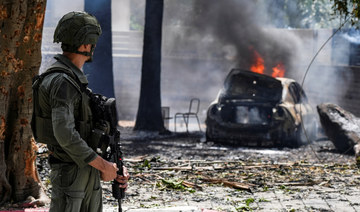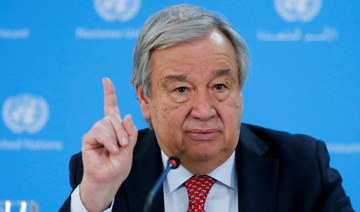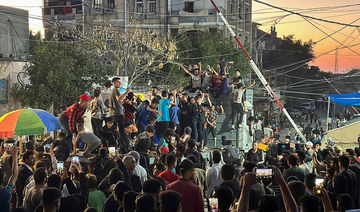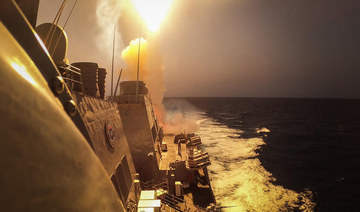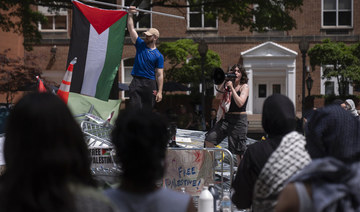AL-HOL, Syria: At the sprawling Al-Hol camp, children pass their days roaming the dirt roads, playing with mock swords and black banners in imitation of Daesh group militants. Few can read or write. For some, the only education is from mothers giving them Daesh propaganda.
It has been more than two years since the Daesh group’s self-declared “caliphate” was brought down. And for more than two years, some 27,000 children have been left to languish in Al-Hol camp in northeast Syria where families of Daesh members have been housed.
They are spending their childhood in a limbo of miserable conditions with no schools, no place to play or develop and seemingly no international interest in resolving their situation.
Only one institution is left to mold them: sympathizers and remnants of the Daesh group who operate within the camp, even as it is run by the Kurdish-led forces that defeated the militants.
Kurdish authorities and aid groups fear the camp will create a new generation of militants. They are pleading with home countries to take the women and children back. The problem is that home governments often see the children as posing a danger rather than as needing rescue.
“These children are Daesh’s first victims,” said Save the Children’s Syria Response Director Sonia Khush. “A 4-year-old boy does not really have an ideology. He has protection and learning needs.”
“The camps are no place for children to live or grow up,” she said. “It does not allow them to learn, socialize or be children ... It does not allow them to heal from all that they have lived through.”
In the fenced-off camp, multiple families are often crammed together in tents; medical facilities are minimal, access to clean water and sanitation limited.
Some 50,000 Syrians and Iraqis are there. Nearly 20,000 of them are children. Most of the rest are women, the wives and widows of fighters.
In a separate, heavily guarded section of the camp known as the annex are another 2,000 women from 57 other countries, considered the most die-hard Daesh supporters, along with their children, numbering 8,000.
The Daesh influence was clear during a rare visit by The Associated Press to the camp last month. Around a dozen young boys in the annex hurled stones at the team, which was accompanied by Kurdish guards. A few waved sharp pieces of metal like swords.
“We will kill you because you are an infidel,” screamed one child who looked around 10. “We are the Islamic State.”
Another child slid his hand across his neck and said, “With the knife, God willing.”
At a market inside the annex, one woman looked at a reporter and said, “The Islamic State endures” — a slogan of the group.
During its nearly 5-year rule over much of Syria and Iraq, Daesh aimed to entrench its “caliphate” by indoctrinating children in its brutal interpretation of Islamic law. It trained children as fighters, taught them how to carry out beheadings using dolls, and even had them carry out killings of captives in propaganda videos.
A Russian-speaking woman in the annex, who identified herself as Madina Bakaraw, said she feared for the future of the children, including her own son and daughter.
“We want our children to learn. Our children should be able to read, to write, to count,” said the 42-year-old. “We want to go home and want our children to have a childhood.”
The women in the camp are a mix. Some remain devoted to Daesh, but others became disillusioned by its brutal rule or by its defeat. Others were never ideologically committed but were brought into the “caliphate” by husbands or family.
The camp began to be used to house the families of Daesh fighters in late 2018 as US-backed Kurdish-led forces recaptured territory in eastern Syria from the militants. In March 2019, they seized the last Daesh-held villages, ending the “caliphate” that the group declared over large parts of Iraq and Syria in 2014.
Since then, Kurdish administrators have struggled to repatriate camp residents in the face of local opposition to their return. Earlier this year, hundreds of Syrian families left the camp after a deal was reached with their tribes to accept them. Last month, 100 Iraqi families were repatriated but still face sharp opposition among their neighbors.
Some former Soviet Union states have let back some of their citizens, but other Arab, European and African countries have repatriated only minimal numbers or have refused.
“Those children are there through no fault of their own, and they should not pay the consequences of their parents’ choices,” Ted Chaiban, Mideast and North Africa director of the UN children’s agency, UNICEF, told the AP. Chaiban visited Al-Hol in December.
If home countries won’t repatriate, at least they should help set up facilities to improve children’s lives, said Shixmus Ehmed, head of the Kurdish-led administration’s department for refugees and displaced.
“We have suggested schools be opened, as well as rehabilitation programs and fields to do sports,” Ehmed said. “But so far, there is nothing.”
In the camp’s main section, UNICEF and Kurdish authorities set up 25 learning centers, but they have been closed since March 2020 because of COVID-19. In the annex, authorities have been unable to set up learning centers. Instead, children are largely taught by their mothers, mostly with Daesh ideology, according to UN and Kurdish officials.
In late March, the Kurdish-led forces assisted by US forces swept through the camp, seizing 125 suspected Daesh operatives, including Iraqis and Syrians.
Those sleeper cells had been killing residents suspected of abandoning the group’s ideology, working as informants or defying its rules. At least 47 people were killed this year, according to Kurdish-led forces, while US officials put the number at 60.
Amal Mohammed, a 40-year-old Iraqi in the camp, said her wish is to return to Iraq where her daughters can live a normal life.
“What is the future of these children?” she said. “They will have no future ... Here they are learning nothing.”
In Syria camp, forgotten children left to be molded by Daesh
https://arab.news/8bc7w
In Syria camp, forgotten children left to be molded by Daesh
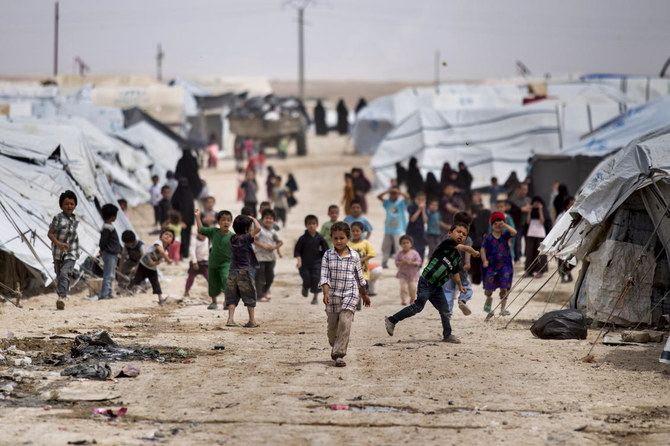
- For more than two years, some 27,000 children have been left to languish in Al-Hol camp in northeast Syria
- Few of the children can read or write, for some their education comes in the form of Daesh propaganda read to them by their mothers
’Unlike anything we have studied’: Gaza’s destruction in numbers
- The level of destruction in northern Gaza has surpassed that of the German city of Dresden, which was firebombed by Allied forces in 1945 in one of the most controversial Allied acts of World War II
“The rate of damage being registered is unlike anything we have studied before. It is much faster and more extensive than anything we have mapped,” said Corey Scher, a PhD candidate at the City University of New York, who has been researching satellite imagery of Gaza.
As Israel launches an offensive on Rafah, the last population center in Gaza yet to be entered by its ground troops, AFP looks at the territory’s shattered landscape seven months into the war sparked by Hamas’s unprecedented October 7 attack.
Gaza is one of the most densely populated places on the planet, where before the war 2.3 million people had been living on a 365-square-kilometer strip of land.
According to satellite analyzes by Scher and Jamon Van Den Hoek, an associate professor of geography at Oregon State University, 56.9 percent of Gaza buildings were damaged or destroyed as of April 21, totaling 160,000.
“The fastest rates of destruction were in the first two to three months of the bombardment,” Scher told AFP.
In Gaza City, home to some 600,000 people before the war, the situation is dire: almost three-quarters (74.3 percent) of its buildings have been damaged or destroyed.
During the war, Gaza’s hospitals have been repeatedly attacked by Israel, which accuses Hamas of using them for military purposes, a charge the militant group denies.
In the first six weeks of the war sparked by the Hamas attack, which killed more than 1,170 people according to an AFP tally of Israeli official figures, “60 percent of health care facilities... were indicated as damaged or destroyed,” Scher said.
The territory’s largest hospital, Al-Shifa in Gaza City, was targeted in two offensives by the Israeli army, the first in November, the second in March.
The World Health Organization said the second operation reduced the hospital to an “empty shell” strewn with human remains.
Five hospitals have been completely destroyed, according to figures compiled by AFP from the OpenStreetMap project, the Hamas health ministry and the United Nations Satellite Center (UNOSAT). Fewer than one in three hospitals — 28 percent — are partially functioning, according to the UN.
The territory’s largely UN-run schools, where many civilians have sought refuge from the fighting, have also paid a heavy price.
As of April 25, UNICEF counted 408 schools damaged, representing at least 72.5 percent of its count of 563 facilities.
Of those, 53 school buildings have been completely destroyed and 274 others have been damaged by direct fire.
The UN estimates that two-thirds of the schools will need total or major reconstruction to be functional again.
Regarding places of worship, combined data from UNOSAT and OpenStreetMap show 61.5 percent of mosques have been damaged or destroyed.
The level of destruction in northern Gaza has surpassed that of the German city of Dresden, which was firebombed by Allied forces in 1945 in one of the most controversial Allied acts of World War II.
According to a US military study from 1954, quoted by the Financial Times, the bombing campaign at the end of World War II damaged 59 percent of Dresden’s buildings.
In late April, the head of the UN mine clearance program in the Palestinian territories, Mungo Birch, said there was more rubble to clear in Gaza than in Ukraine, which was invaded by Russia more than two years ago.
The UN estimated that as of the start of May, the post-war reconstruction of Gaza would cost between 30 billion and 40 billion dollars.
HRW: Israel attack on Lebanon rescuers was ‘unlawful’
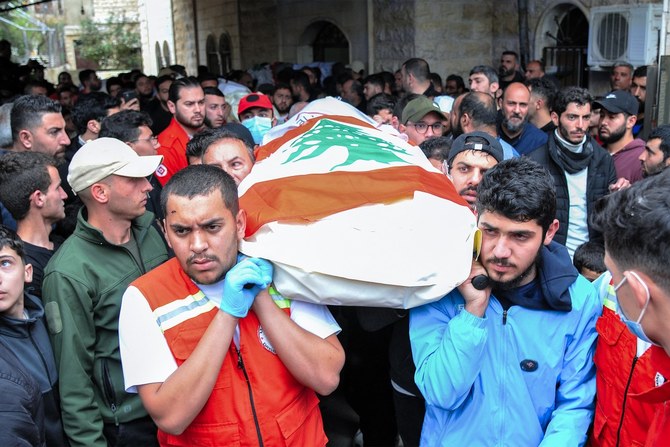
- The rights group urged the United States to “immediately suspend arms sales and military assistance to Israel
Beirut: Human Rights Watch said Tuesday an Israeli strike in Lebanon that killed seven first responders was “an unlawful attack on civilians,” and urged Washington to suspend weapons sales to Israel.
The Israel-Lebanon border area has witnessed near-daily exchanges between the Israeli army and Hamas ally Hezbollah since the Palestinian militant group attacked southern Israel on October 7 sparking war in Gaza.
“An Israeli strike on an emergency and relief center” in the southern village of Habariyeh on March 27 “killed seven emergency and relief volunteers” and constituted an “unlawful attack on civilians that failed to take all necessary precautions,” HRW said in a statement.
“If the attack on civilians was carried out intentionally or recklessly, it should be investigated as an apparent war crime,” it added.
The Israeli military did not immediately comment when contacted by AFP.
But at the time the military said the target was “a military compound” and that the strike killed a “significant terrorist operative” from Jamaa Islamiya, a Lebanese group close to Hamas, and other “terrorists.”
HRW said in the statement that it found “no evidence of a military target at the site,” and said the Israeli strike “targeted a residential structure that housed the Emergency and Relief Corps of the Lebanese Succour Association, a non-governmental humanitarian organization.”
Jamaa Islamiya later denied it was connected to the emergency responders, and the association told AFP it had no affiliation with any Lebanese political organization.
HRW said “the Israeli military’s admission” it had targeted the center in Habariyeh indicated a “failure to take all feasible precautions to verify that the target was military and avoid loss of civilian life... making the strike unlawful.”
The rights group said those killed were volunteers, adding that 18-year-old twin brothers were among the dead.
“Family members... the Lebanese Succour Association, and the civil defense all said that the seven men were civilians and not affiliated with any armed group,” it added.
However, it noted that social media content suggested at least two of those killed “may have been supporters” of Jamaa Islamiya.
HRW said images of weapons parts found at the site included the remains of an Israeli bomb and remnants of a “guidance kit produced by the US-based Boeing Company.”
“Israeli forces used a US weapon to conduct a strike that killed seven civilian relief workers in Lebanon who were merely doing their jobs,” HRW’s Lebanon researcher, Ramzi Kaiss, said.
The rights group urged the United States to “immediately suspend arms sales and military assistance to Israel given evidence that the Israeli military is using US weapons unlawfully.”
Israeli military take control of vital Rafah crossing from Gaza into Egypt
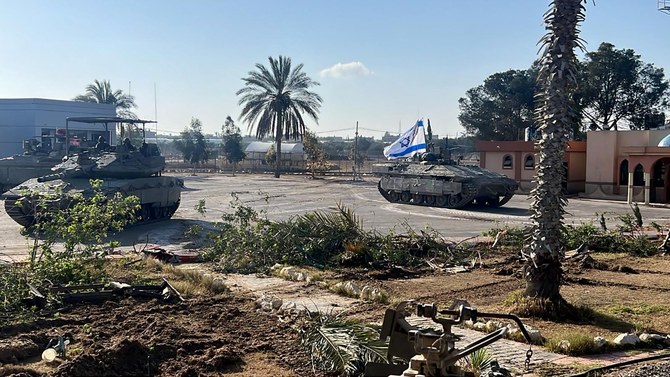
- Israel military takes control of Rafah crossing, special forces scanning area
- Israel says vast majority of people evacuated from military area
JERUSALEM: The Israeli military took control of the vital Rafah border crossing between Gaza and Egypt on Tuesday, pushing into the southern Gazan town after a night of air strikes and as prospects for a ceasefire deal hung in the balance.
The Palestinian militant group Hamas said late on Monday it had agreed to a ceasefire proposal from mediators seven months into the war that has pushed more than a million Gazans into the south of the enclave.
Israel said the terms did not meet its demands and launched a military operation in Rafah.
Israeli tanks and planes pounded several areas and houses in Rafah overnight, killing 20 Palestinians and wounding several others in strikes that hit at least four houses, Palestinian health officials said.
“The Israeli occupation has sentenced the residents of the Strip to death after closure of the Rafah border crossing,” said Hisham Edwan, spokesman for the Gaza Border Crossing Authority. It also condemned to death cancer patients due to the collapse of the health care system, he added.
Israel has been threatening to launch a major incursion in Rafah, which it says harbors thousands of Hamas fighters and potentially dozens of hostages. Victory is impossible without taking Rafah, it says.
Rafah crossing closed
A Gaza border authority spokesperson told Reuters the Rafah crossing, a major route for aid into the devastated enclave, was closed because of the presence of Israeli tanks. Israel’s Army Radio had earlier announced its forces were there.
The United States has been pressing Israel not to launch a military campaign in Rafah until it had drawn up a humanitarian plan for the Palestinians sheltering there, which Washington says it has yet to see.
Israel said the vast majority of people had been evacuated form the area of military operations.
Instructed by Arabic text messages, phone calls and flyers to move to what the Israeli military called an “expanded humanitarian zone” around 20 km (12 miles) away, some Palestinian families began trundling away in chilly spring rain.
Some piled children and possessions onto donkey carts, while others left by pick-up or on foot through muddy streets.
As families dismantled tents and folded belongings, Abdullah Al-Najar said this was the fourth time he had been displaced since the fighting began seven months ago.
“God knows where we will go now. We have not decided yet.”
Truce talks in Cairo
Hamas said in a brief statement that its chief, Ismail Haniyeh, had informed Qatari and Egyptian mediators the group accepted their proposal for a ceasefire.
Israeli Prime Minister Benjamin Netanyahu’s office said later the truce proposal fell short of Israel’s demands but Israel would send a delegation to meet with negotiators to try to reach an agreement.
Qatar’s foreign ministry said its delegation will head to Cairo on Tuesday to resume indirect negotiations between Israel and Hamas.
In a statement, Netanyahu’s office said his war cabinet approved continuing an operation in Rafah. Jordan’s Foreign Minister Ayman Safadi said on social media site X that Netanyahu was jeopardizing a ceasefire by bombing Rafah.
An Israeli official, speaking on condition of anonymity, said the proposal that Hamas approved was a watered-down version of an Egyptian offer and included elements Israel could not accept.
“This would appear to be a ruse intended to make Israel look like the side refusing a deal,” said the Israeli official.
Another official briefed on the agreement said Hamas had agreed to the phased ceasefire and hostage release deal Israel proposed on April 27 with only minor changes that did not affect the main parts of the proposal.
US State Department spokesman Matthew Miller said Washington would discuss the Hamas response with its allies in the coming hours, and a deal was “absolutely achievable.”
Any truce would be the first pause in fighting since a week-long ceasefire in November, during which Hamas freed around half of the hostages.
Since then, all efforts to reach a new truce have foundered over Hamas’ refusal to free more hostages without a promise of a permanent end to the conflict, and Israel’s insistence that it would discuss only a temporary pause.
More than 34,600 Palestinians have been killed in the conflict, according to Gaza health officials. The UN has said famine is imminent in the enclave.
The war began when Hamas militants attacked Israel on Oct. 7, killing about 1,200 people and abducting 252 others, of whom 133 are believed to remain in captivity in Gaza, according to Israeli tallies.
UKMTO receives report two explosions south of Yemen’s Aden
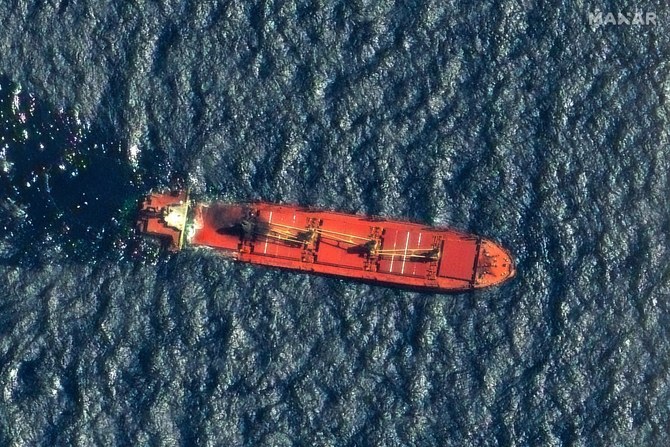
- The Houthi militia that controls the most populous parts of Yemen and is aligned with Iran have staged attacks on ships in the waters off the country for months
Dubai: A merchant vessel passing through the Gulf of Aden off Yemen reported two explosions in “close proximity,” British maritime security agency UKMTO said Tuesday.
The United Kingdom Maritime Trade Operations said the “vessel and all crew are safe,” adding that “authorities are investigating” the blasts south of Yemen’s southern port city of Aden.
UKMTO, which is run by Britain’s Royal Navy, did not provide details on the ship or the nature of attack.
Yemen’s Iran-backed Houthi rebels have launched dozens of drone and missile strikes against ships in the Red Sea and the Gulf of Aden since November.
The Houthis say their campaign is in solidarity with Palestinians amid the Gaza war.
On Friday, they threatened to expand operations targeting Israel-bound shipping to the Mediterranean Sea.
The United States announced an initiative in December to protect Red Sea shipping from Houthi attacks, which have prompted major firms to avoid the route that normally carries 12 percent of global trade.
Since January, the US and Britain have also launched repeated retaliatory strikes on Houthi targets in Yemen.
On Monday, US military forces downed a drone launched by the Houthis over the Red Sea, the US military’s Central Command (CENTCOM) said in a statement.
The drone “presented an imminent threat to US coalition forces and merchant vessels in the region,” CENTCOM said.
Palestinians seek UN General Assembly backing for full membership

- Diplomats say 193-member General Assembly likely to back Palestinian bid
- Others say move could set precedent for others, citing Kosovo and Taiwan as examples
UNITED NATIONS: The United Nations General Assembly could vote on Friday on a draft resolution that would recognize the Palestinians as qualified to become a full UN member and recommend that the UN Security Council “reconsider the matter favorably.”
It would effectively act as a global survey of how much support the Palestinians have for their bid, which was vetoed in the UN Security Council last month by the United States. An application to become a full UN member needs to be approved by the 15-member Security Council and then the General Assembly.
Diplomats say the 193-member General Assembly is likely to back the Palestinian bid. But changes could still be made to the draft after some diplomats raised concerns with the current text, seen by Reuters, that also grants additional rights and privileges — short of full membership — to the Palestinians.
Some diplomats say this could set a precedent for other situations, citing Kosovo and Taiwan as examples.
Israel’s UN Ambassador Gilad Erdan on Monday denounced the current draft General Assembly resolution, saying it would give the Palestinians the de facto status and rights of a state and goes against the founding UN Charter.
“If it is approved, I expect the United States to completely stop funding the UN and its institutions, in accordance with American law,” said Erdan, adding that adoption by the General Assembly would not change anything on the ground.
US CONCERNS
Under US law, Washington cannot fund any UN organization that grants full membership to any group that does not have the “internationally recognized attributes” of statehood. The US halted funding in 2011 for the UN cultural agency (UNESCO)after the Palestinians became a full member.
“It remains the US view that the path toward statehood for the Palestinian people is through direct negotiations,” said Nate Evans, spokesperson for the US mission to the UN
“We are aware of the resolution and reiterate our concerns with any effort to extend certain benefits to entities when there are unresolved questions as to whether the Palestinians currently meet the criteria under the Charter,” he said.
The Palestinians are currently a non-member observer state, a de facto recognition of statehood that was granted by the UN General Assembly in 2012. The Palestinian mission to the UN in New York did not immediately respond to a request for comment on its push for action in the General Assembly.
The Palestinian push for full UN membership comes seven months into a war between Israel and Palestinian militants Hamas in the Gaza Strip, and as Israel is expanding settlements in the occupied West Bank, which the UN considers to be illegal. The United Nations has long endorsed a vision of two states living side by side within secure and recognized borders.
Palestinians want a state in the West Bank, east Jerusalem and Gaza Strip, all territory captured by Israel in 1967.



